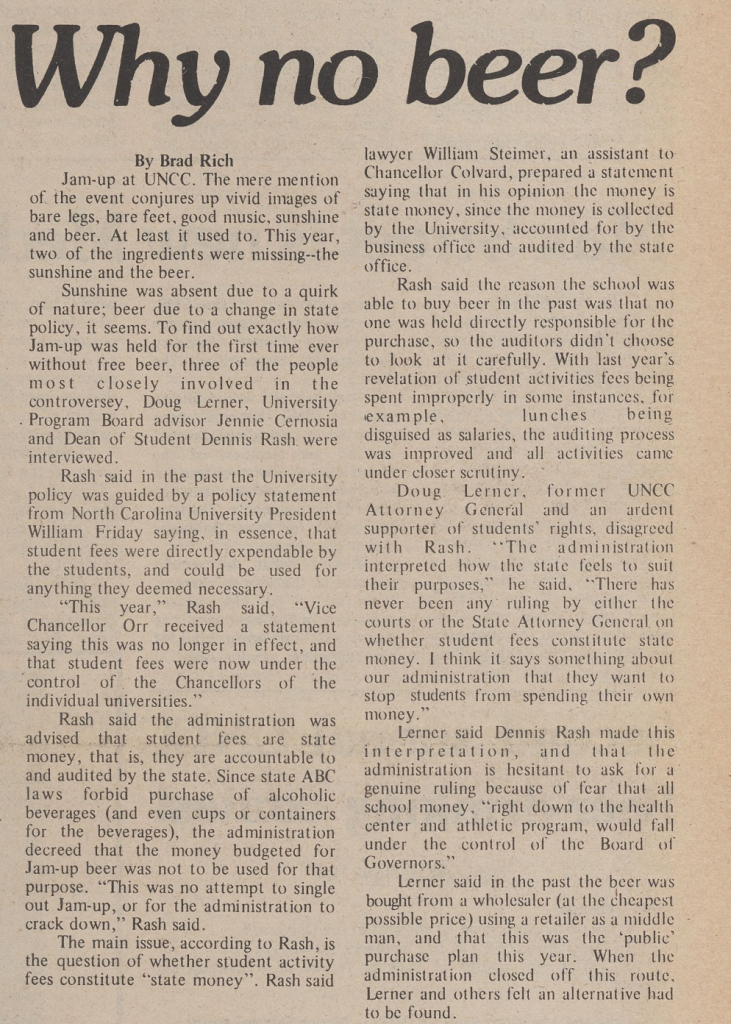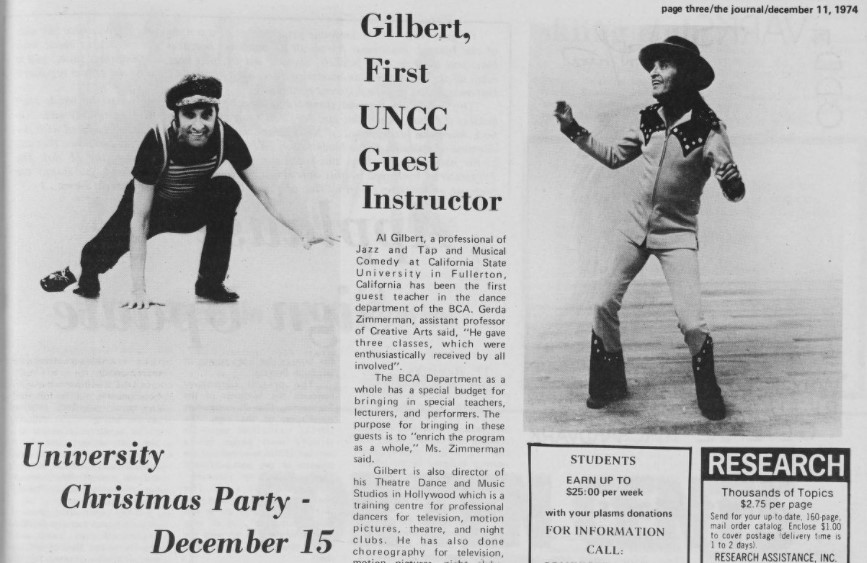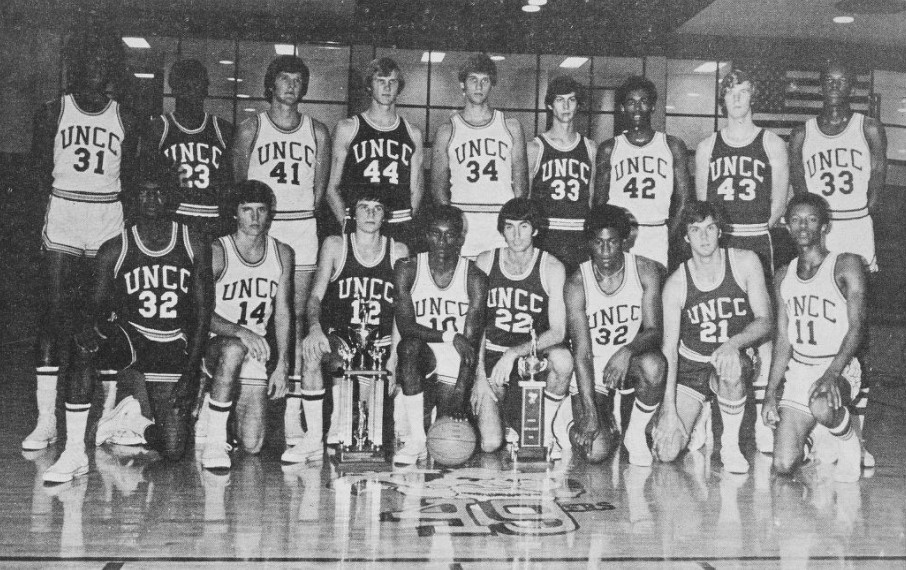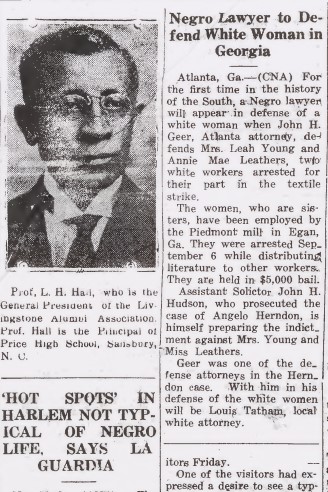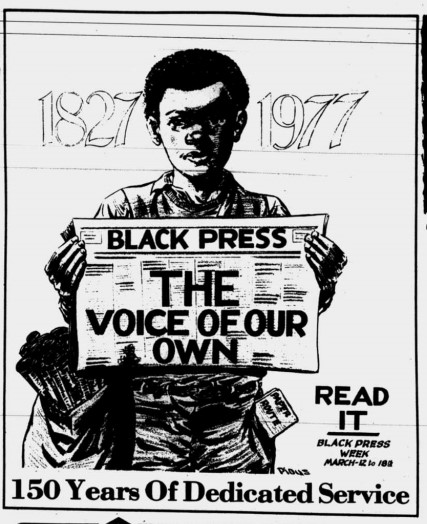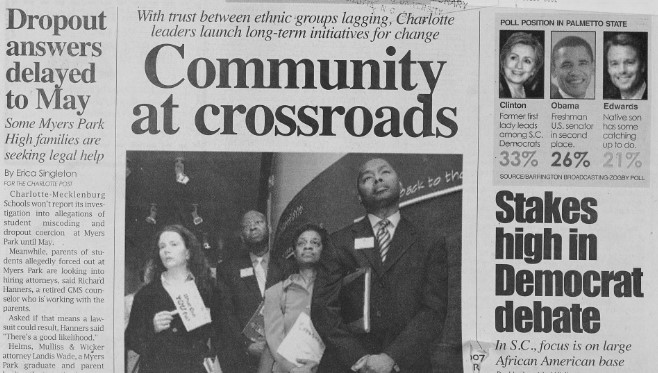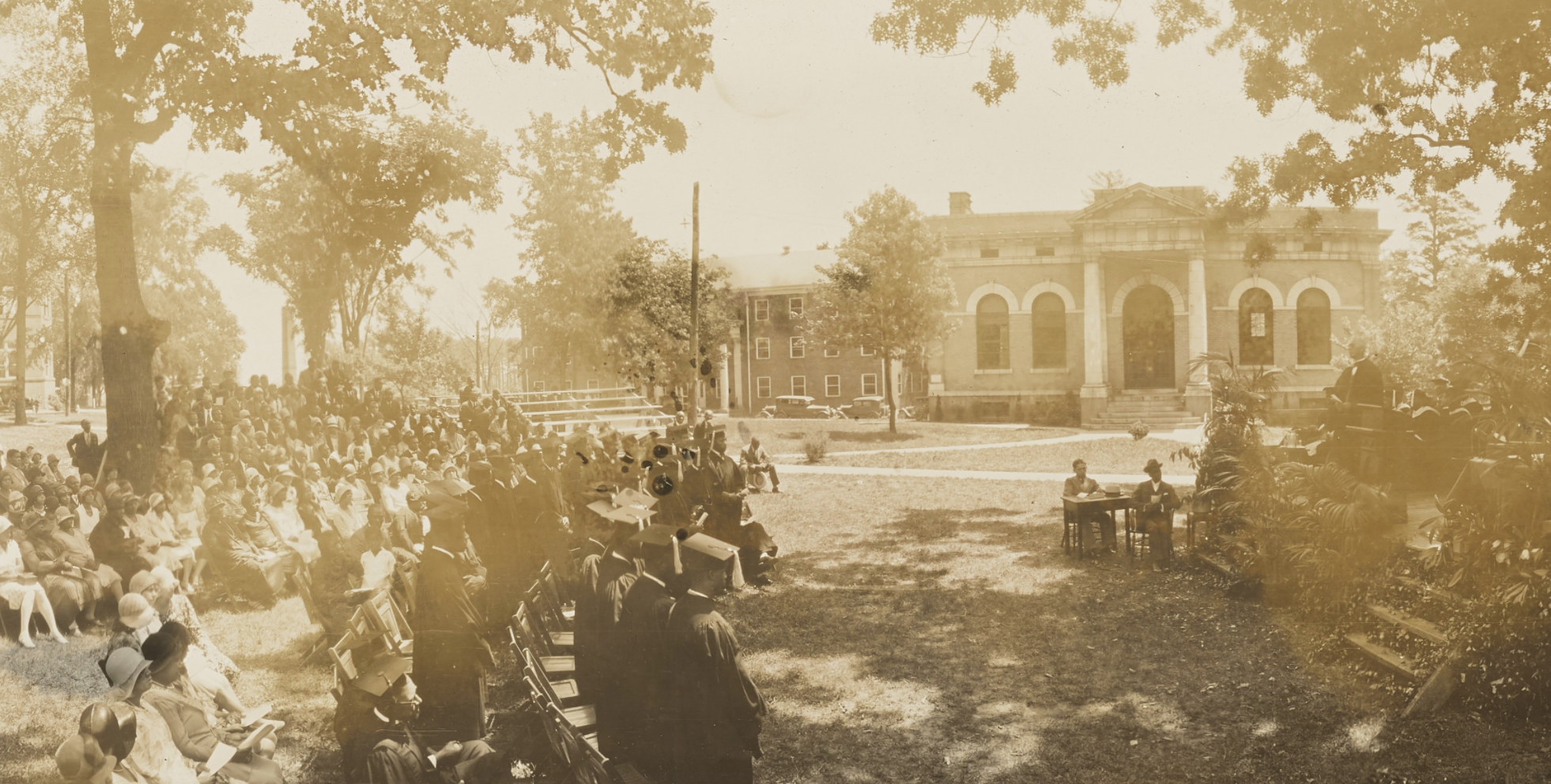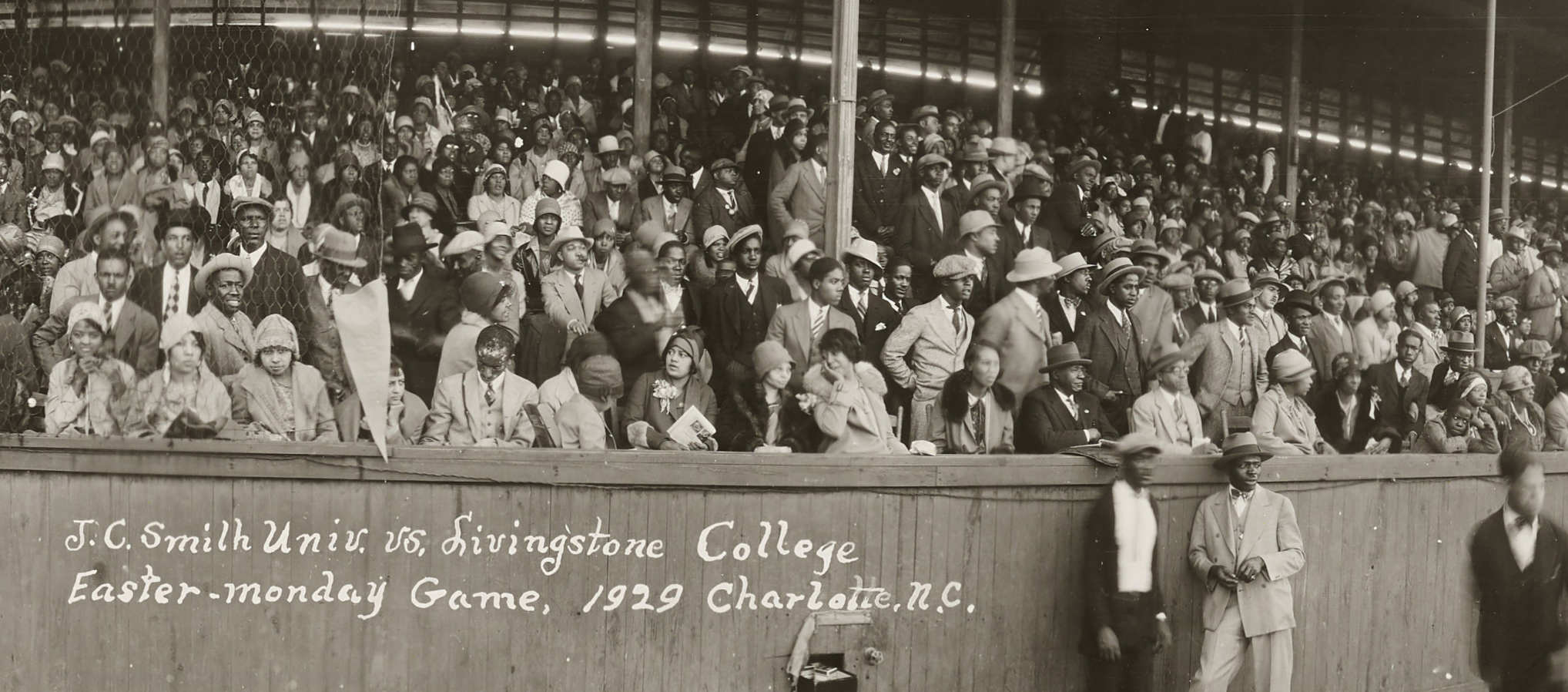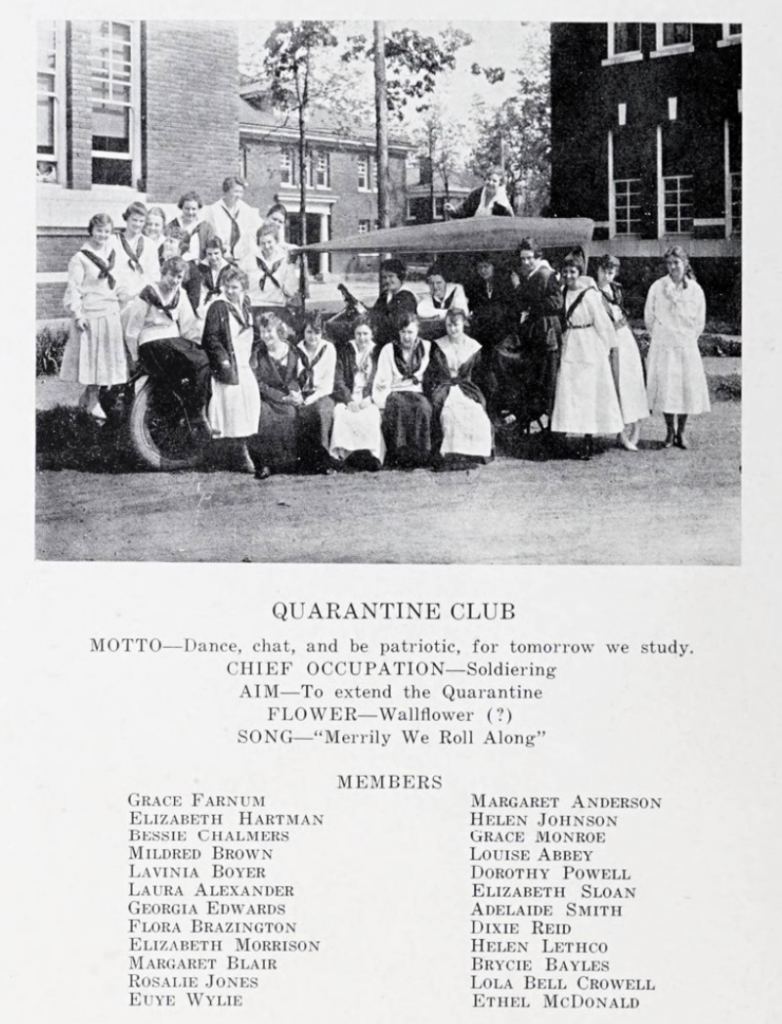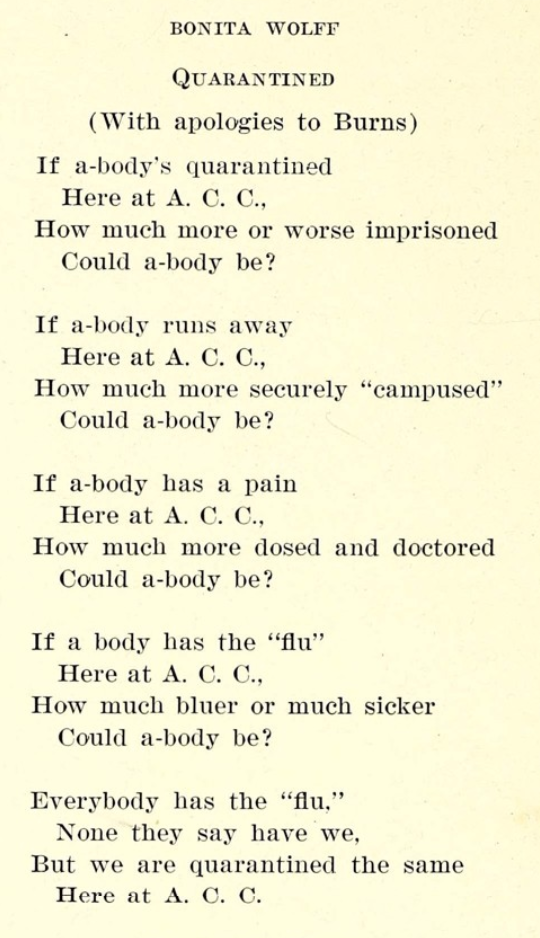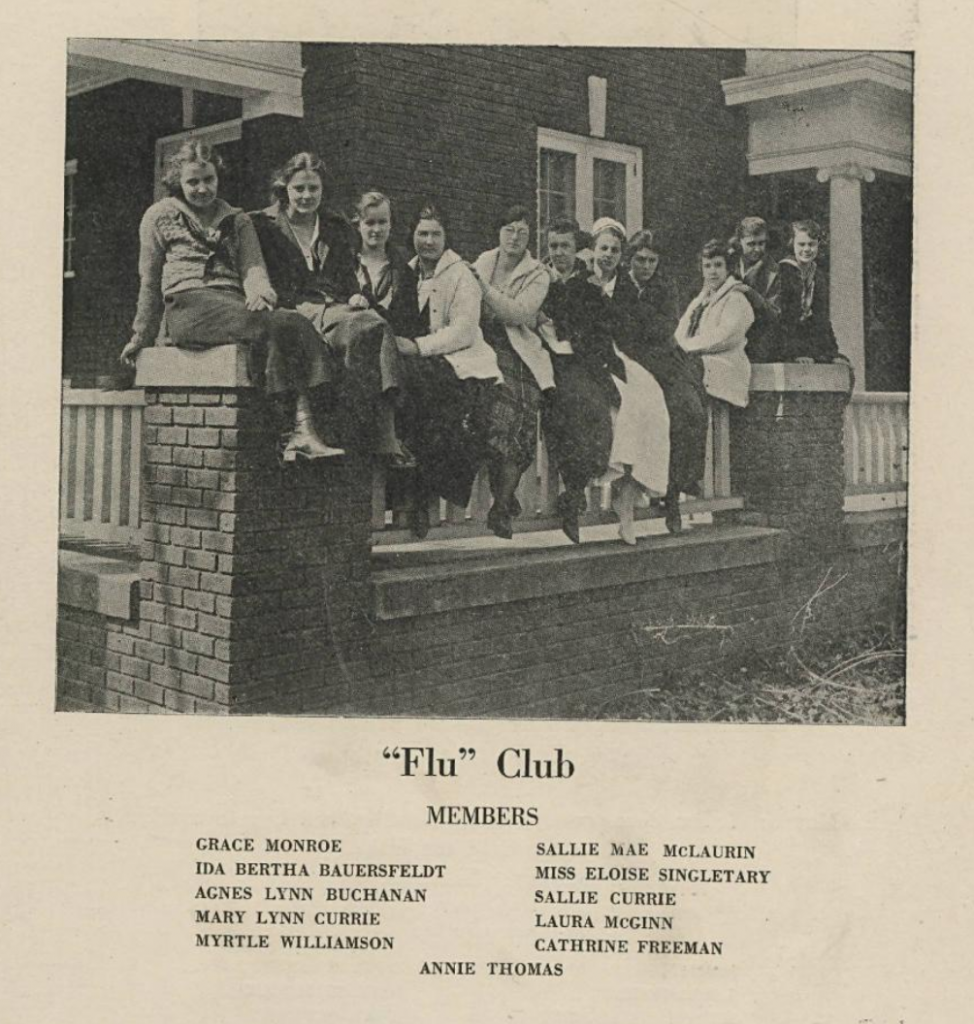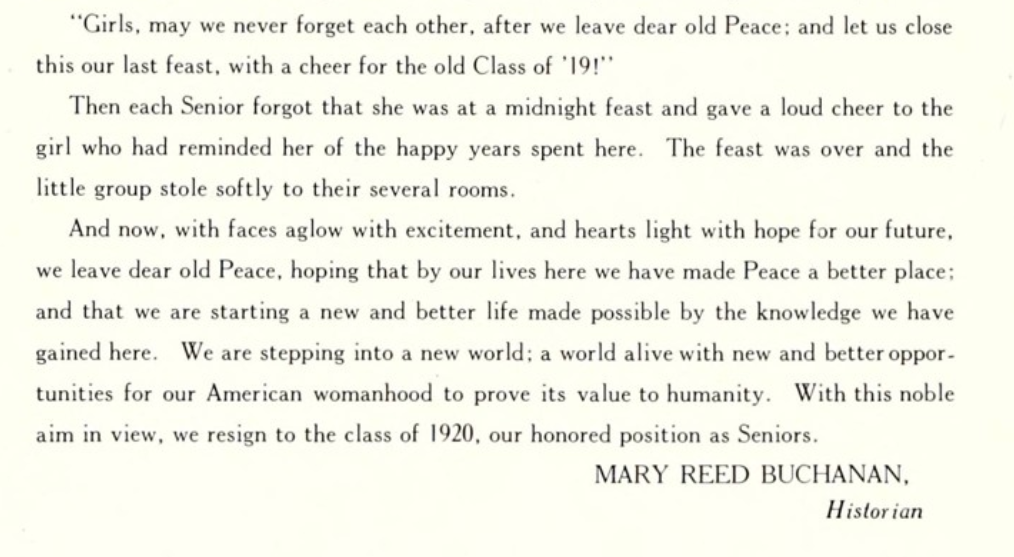Viewing search results for "University of North Carolina at Charlotte"
View All Posts
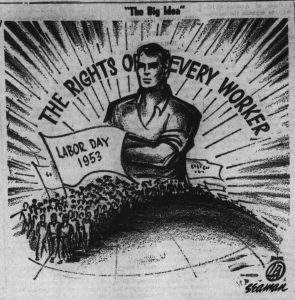
“The Big Idea,” 1953
Issues of the Charlotte Labor Journal and Dixie Farm News from 1935-1953 are now available in our North Carolina Newspapers collection thanks to our partner the University of North Carolina at Charlotte. According to the Library of Congress, the paper was published weekly as the “organ of the Charlotte Central Labor Union.”
The first issue we have online, from January 24, 1935, was published less than a year after the General Strike of 1934, when between 300,000 and 500,000 textile workers along the East Coast (most from North and South Carolina) protested working conditions. Despite the large turnout and national recognition, though, workers in the Southern states did not see their demands met, which made many members lose faith in their unions.
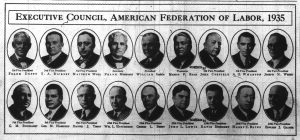
Portraits of the AFL Council from January 24, 1935
The issues that we have online roughly follow the trajectory of organized labor in the state overall; the last issue we have is from 1953, when Operation Dixie officially ended, ultimately failing to unite textile workers into a single large union. Part of that failure stemmed from opposition by the AFL, the union behind the Charlotte Labor Journal.
To see more materials from UNC Charlotte, visit their partner page or their library website. To see more digital content about labor unions in North Carolina, click here.
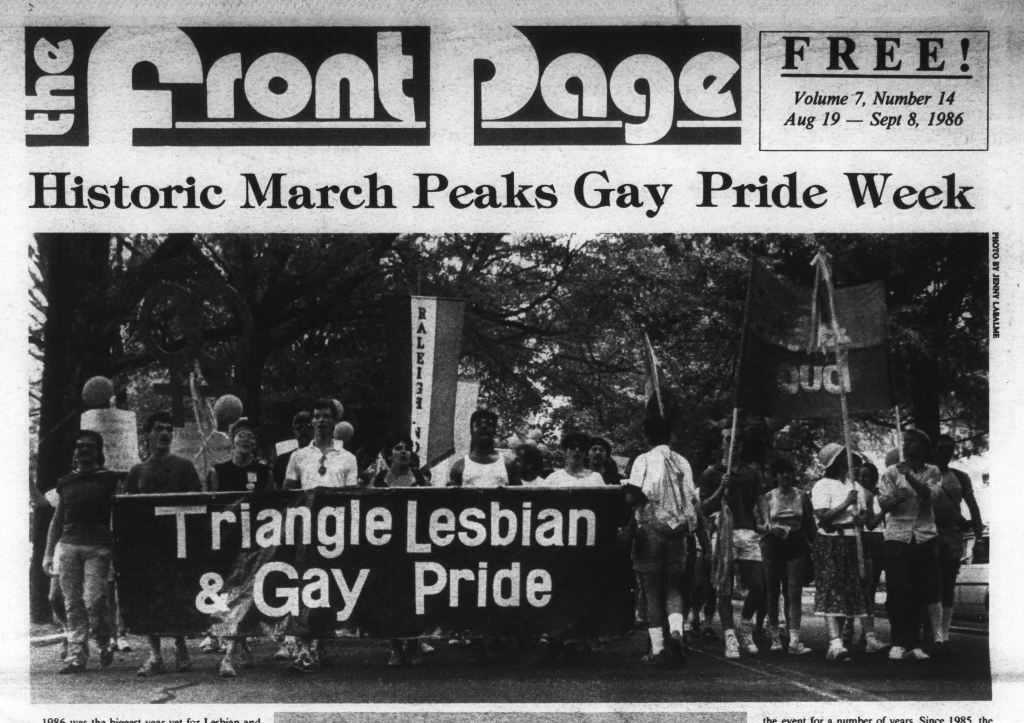 The first 8 years of The Front Page newspaper, from 1979-1986, are now on DigitalNC. The Front Page was published in Raleigh for twenty-six years covering “news and happenings of interest to gay people.” The paper covered national and local news impacting and of interest to the LGBTQ+ community. There are ads for local businesses that were safe spaces for LGBTQ+ individuals, and a community calendar listed events. There’s also a Q&A column where letters from readers all over the state wrote in with problems or questions to recieve a broad spectrum of personal advice.
The first 8 years of The Front Page newspaper, from 1979-1986, are now on DigitalNC. The Front Page was published in Raleigh for twenty-six years covering “news and happenings of interest to gay people.” The paper covered national and local news impacting and of interest to the LGBTQ+ community. There are ads for local businesses that were safe spaces for LGBTQ+ individuals, and a community calendar listed events. There’s also a Q&A column where letters from readers all over the state wrote in with problems or questions to recieve a broad spectrum of personal advice.
Q-Notes, a prominent Charlotte area LGBTQ+ newspaper and the one Front Page merged with in 2006, published a retrospective of The Front Page and an interview with the Page‘s publisher Jim Baxter in the July 29, 2006 issue. Baxter penned an article in IndyWeek shortly after the paper’s final issue, and it describes parts of his career and the history of Front Page.
The paper has been added with kind permission from the publishers and thanks to efforts by staff at the libraries at the University of North Carolina at Charlotte and Duke University. Digitization of this paper was funded by an IDEA Action Grant from UNC-Chapel Hill Libraries. Archived issues of Q-notes are available from our site, and you can view more current content at their site.
Thanks to our partner, Johnson C. Smith University, a batch of materials including documents from Catawba Presbytery, issues of The Charlotte Post, a book on Johnson C. Smith University’s first female president, and more are now available on our website.
The book, The Yancy Years 1994-2008: The Age of Infrastructure, Technology and Restoration, is an educational narrative about Johnson C. Smith University’s first female president, Dr. Dorothy Cowser Yancy. The first half of the book is split into three different parts with each part representing a different phase of her time as president. One of the biggest impacts Dr. Yancy had on the university during her time as president was her investment in technology. She switched the campus to using email, expanded wireless capabilities, upgraded campus technology, and acquired laptops for students and faculty. In addition, Dr. Yancy brought Johnson C. Smith University into a new realm of success which placed the school on the national stage.

Dr. Yancy shares a hug with NBA legend Earvin “Magic” Johnson during a talk inside the Sarah Belk Gambrell Auditorium at Biddle Memorial Hall.
The last half of the book features a 14-year financial overview of the university and a look at the 2006-2015 master plan. The book’s final chapter, “A Daughter’s Perspective on Dorothy Cowser Yancy,” is written by Dr. Yancy’s daughter, Yvonne. In it, Yvonne discusses her mother and their close relationship.

Yvonne Cowser Yancy and her mother, Dr. Dorothy Cowser Yancy at the “Diamond President” Gala Celebration in April, 2008.
To learn more about Johnson C. Smith University, please visit their website.
To view issues of The Charlotte Post, please click here.
To view more newspapers from around North Carolina, please visit our North Carolina Newspapers Collection.

Thanks to our partner, University of North Carolina at Charlotte (UNCC), 55 new issues of UNCC’s student newspaper The Carolina Journal are now available on our website. This batch expands our current holdings of the newspaper to include issues from 1976 to 1978. The Carolina Journal covers topics such as college athletics, social events, problems and issues related to campus, and more.
One problem reported on by The Carolina Journal was the lack of beer at the Jam-Up UNCC event. Traditionally, the event had included “bare legs, bare feet, good music, sunshine and beer,” according to writer Brad Rich. But that year, 1977, the beer was missing and students were curious as to why.
Rich’s investigation into the problem did not yield any definitive answers, but created even more questions. According to the Dean of Students, student fees were considered state money and since they were considered the state’s money, it was against state ABC laws for the University to buy alcohol. The Dean says the reason they were allowed to buy beer before was simply because no one was held directly responsible for the purchase of the alcohol. The former Attorney General, however, stated that the administration at UNCC did not definitively know if student fees counted as state money, but were afraid if they asked that all the money, such as what they earn on athletics, could fall under the control of the Board of Governors. To read the “Why No Beer? article in its entirety, please click here.
To learn more about the University of North Carolina at Charlotte, please visit their website.
To view more newspapers from across North Carolina, please click here.
Over 50 issues of The Carolina Journal, also titled as The Journal, the student newspaper published by the University of North Carolina at Charlotte, are now available on DigitalNC thanks to our partners at the University of North Carolina at Charlotte. This upload spans about two years, from August 26, 1974 to May 1, 1976.
On August 22, 1975 the newspaper title switches from The Journal back to The Carolina Journal. Coinciding with the return of The Carolina Journal name is the departure of the art focused cover pages and creative layout that marked The Journal’s tenure. By the start of the school year in 1974, the newspaper layout slowly returned to a traditional format.
Along with updating students and the local community on campus developments, The Carolina Journal also frequently advertised notable guest lecturers. Father Daniel Berrigan, an outspoken opponent of the Vietnam War, and Faith Ringgold, an artist and Black feminist, both spoke at UNCC. In addition, UNCC sports were commonly reported on. The 49ers had particularly noteworthy basketball seasons in 1974 and 1975.
To see all of DigitalNC’s digitized content from The Carolina Journal, click here. To view all student newspapers from the University of North Carolina at Charlotte, click here. And to visit UNCC’s homepage, click here.
Just under 50 issues of The Charlotte Post have recently been added to the DigitalNC newspaper collection, rounding out the rest of 2006 and ending on October 11, 2007. If you have been following us closely, you may have noticed that over the past two years we have routinely been scanning and uploading issues of The Charlotte Post. In fact, we now have a grand total of 1,041 issues available to view online! We think this is a cause to celebrate. In this blog, we’ll go through a brief look back at our entire Post collection. Many thanks go out to our long time partners at Johnson C. Smith University for supplying all the issues in this collection.
While a majority of our Post issues are from the mid 1970s to the mid 2000s, the earliest issues come from the 1930s. Since its debut in 1878, the Post has provided an African American perspective on news local to Charlotte, North Carolina and beyond. While we only have three issues from the 30s, they contribute Black voices to our primary source material of that period.
Weekly issues from the 70s through 90s continue to highlight the African American community in and around Charlotte. While the tagline for the Post in the 30s was “The Paper with a Heart and Soul”, in the early 70s it changed to “Charlotte’s Fastest Growing Community Weekly” and then finally landed on “The Voice of the Black Community”. Weekly features become frequent in this era of the Post, such as “Beauty of the Week” and The B.E.E. (Black Entertainment Events) Line.
Once we arrive in the new millennium, issues become longer and have strict sections. These sections cover a wide range of topics typical of modern newspapers: editorials, weather, life, religion, sports, real estate, business, A&E (arts and entertainment), and classifieds. Special editions were also intermittently added to issues, such as the CIAA Basketball Tournament edition and Top Seniors.
The Post continues to be printed to this day and we hope to add many more issues of it for future digital viewing. To start your own Post collection exploration, click here to browse by year. If you would like to look at all African American newspapers on DigitalNC, click here. And to learn more about JCSU, click here.
Five new large format photographs have been added to DigitalNC’s image collection thanks to our partners at Johnson C. Smith University. A historically Black university, Johnson C. Smith University has been a fixture in Charlotte, North Carolina since 1867.
As these new photos are all from the early 1900s, you may notice an institution name change between the image titles. First established as Biddle Memorial Institute, Johnson C. Smith University was known as Biddle University between 1876 and 1923 before arriving at its current name.
Several of these images capture traditional university moments, such as graduation, class photos, and reunions.
Of note is a panoramic photo taken during a 1929 rivalry baseball game. This candid shot of the crowd avidly watching an Easter Monday match between Johnson C. Smith University and Livingstone College depicts just how well attended baseball games were at the time.
As would have been well known in the early 1900s, white baseball teams barred Black players from joining their leagues, effectively segregating the sport. Black communities thus formed their own professional baseball leagues, culminating in a national organization known as the Negro National League, organized by Andrew (Rube) Foster in 1920. Baseball continued to be a popular and lucrative enterprise for the Black community throughout the mid-1900s, splitting into western and eastern circuits. The last of the leagues folded in 1962. While Johnson C. Smith University no longer has a baseball team, spectators can still enjoy following the women’s softball team, the Golden Bulls.
To see the newest photos in their entirety, click here. To view all images from Johnson C. Smith University, click here. And to learn more about Johnson C. Smith University, you can visit their home page here.
Thanks to our partner, the Charlotte Mecklenburg Library, we now have a batch of yearbooks and a digitized book available on our website. The yearbooks span the years 1966-1968 and are from Second Ward Senior High School in Charlotte, N.C. The book is a photographic history of Charlotte native T.D. Elder, entitled T.D. Elder Living Images: Charlotte’s Triumphant Warrior for Black History.
Second Ward Senior High School was established in 1923 as the first public high school for Black students in the Charlotte-Mecklenburg area. Before this school was established, Black students in the area had to move to other areas in order to get a high school education. In the early 1970s, the school was closed and the building was demolished. As was the case in most Southern cities, formerly all-Black high schools were usually torn down or repurposed after school segregation legally ended. Black students were then bused to formerly all-white schools in order to achieve integration. However, the legacy of the school lives on as an important symbol in the history of the Black community of the Charlotte-Mecklenburg area. For more information about Second Ward Senior High School, visit this online exhibit by the Charlotte-Mecklenburg Library.
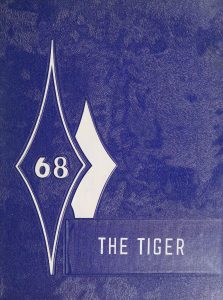
The cover of the 1968 edition of the Second Ward High School yearbook.
Thereasea Clark Elder was born in Charlotte, North Carolina on September 2, 1927. For over eighty years, she served her community as a nurse and community activist. In her lifetime, Elder established both the Greenville Historical Society and the Charlotte Mecklenburg Black Heritage Committee. A number of Charlotte institutions have been named in her honor, including the Thereasea C. Elder Community Health Leadership Academy and the Thereasea Clark Elder Neighborhood Park. For more information about Thereasea Clark Elder and her groundbreaking life and work, there is a 2014 article from the Charlotte Observer dedicated to her story, which can be accessed here.
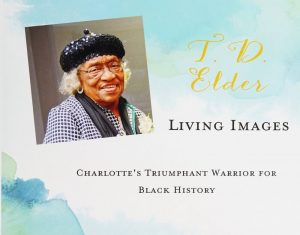
The cover of T.D. Elder Living Images: Charlotte’s Triumphant Warrior for Black History.
For more information about the Charlotte Mecklenburg Library, please visit their website.
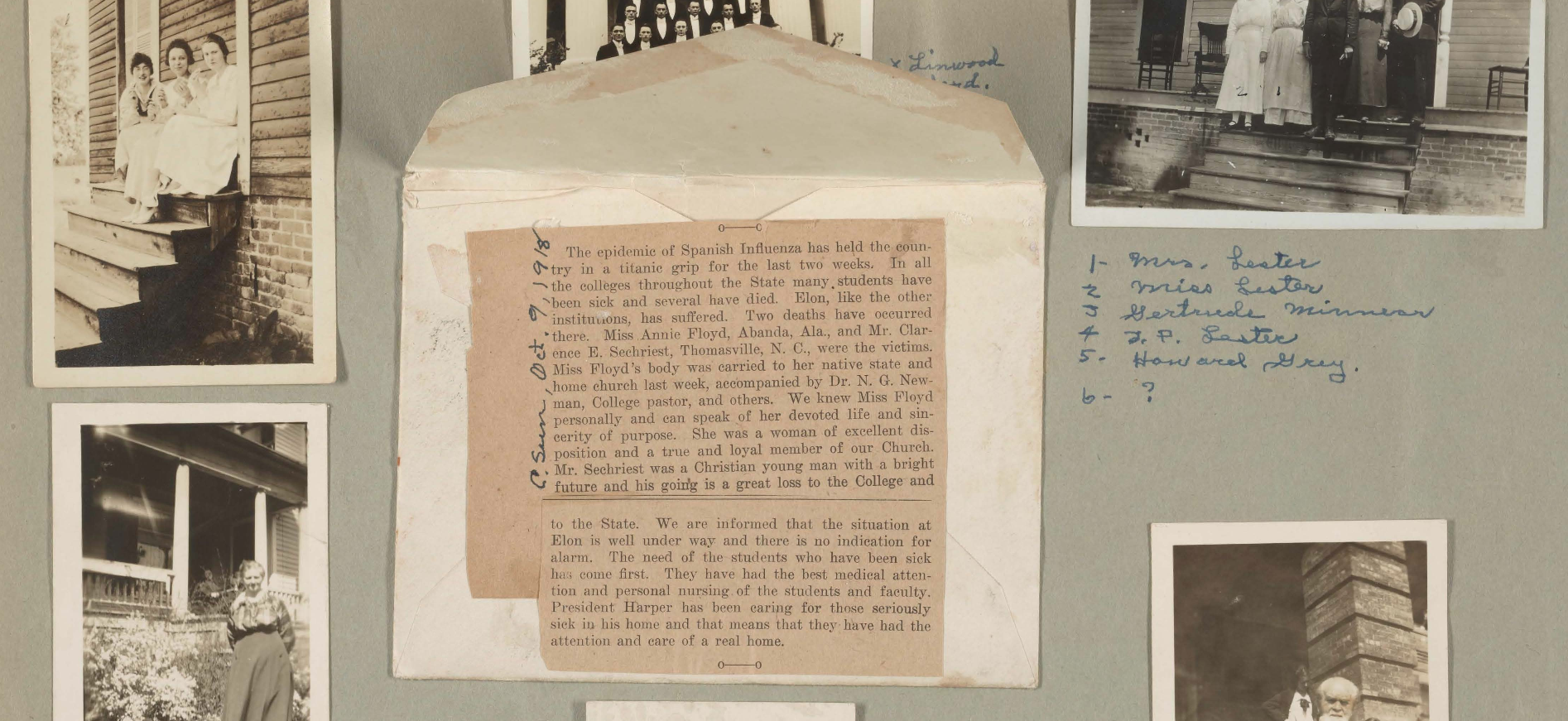
Page 31 of Annie Gordon Floyd’s scrapbook, a student at Elon College during the influenza pandemic of 1918. The newspaper clipping is Annie’s obitual; she died of influenza.
Here at the University of North Carolina, Chapel Hill, as well as across the globe, graduating students are leaving their school years behind without the normal pomp and circumstance. After years of late-night study sessions and racing to beat the assignment submission clock on Sakai, who would have thought that a pandemic would get between them and their walk across the commencement stage? While achieving a degree is a reason to celebrate regardless of location, perhaps 2020 graduates and all self-isolating students can relate to the experiences of an older group of students- those affected by the 1918 influenza pandemic.
Cutting through the spring of 1918 to 1919, the influenza pandemic was a worldwide health issue not unlike today. In North Carolina, industries were halted and quarantine was enacted (and extended). Universities, too, established their own versions of quarantine. Thanks to the institutions we work with here at DigitalNC, we have digitized yearbooks, scrapbooks, and college publications that offer a glimpse into the thoughts of students during this equally tumultuous time in history.
Quarantine was enacted in fits and spurts on campuses across North Carolina between 1918 and 1920. As is evident by yearbook social calendars, measures varied across universities. One campus quarantined through most of November 1918 while others were still starting up quarantine periods in February and March 1920.
Campus clubs have a dedicated slice of yearbook real estate during this time and the influenza directly impacted their activities. As the pandemic coincided with the last days of World War I, Student Army Training Corps (S.A.T.C.) were a part of many universities. The S.A.T.C. at Meredith College recounts their quarantine movements that saved faculty and students from “nervous prostration”. UNC’s S.A.T.C. found the flu less inspiring. Other students responded by creating clubs. At Queens College, Quarantine Club, seen left, first began in 1918 with the aim “to extend the quarantine”. Later, in 1920, the club edited their name to simply “Flu” Club, as seen below.
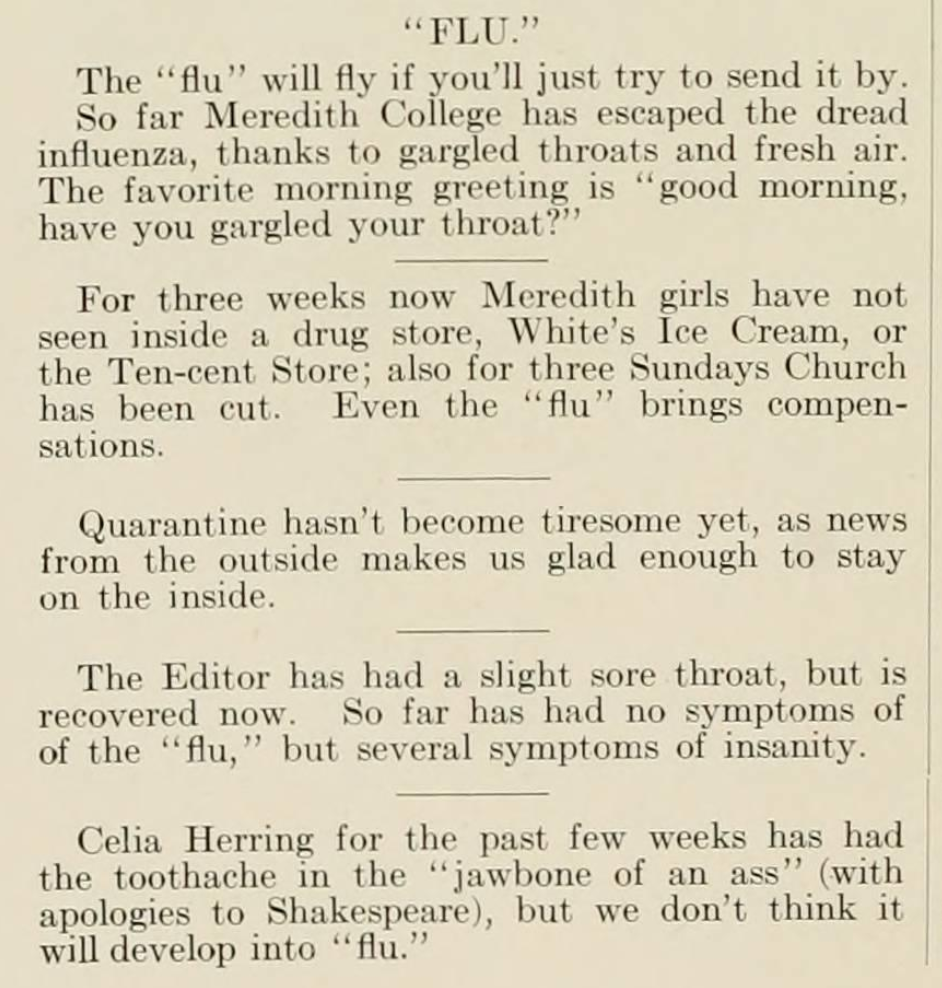
“Flu” section of the Meredith News and Distributor by French Haynes, Oak Leaves, 1919.
Students also utilized their yearbooks to creatively vent frustrations. In 1918, Atlantic Christian College students were under quarantine from February 6th to the 27th. Student Bonita Wolff penned several poems for The Radiant, including “Quarantined”, shown above. Another funny quarantine themed poem can be found in the advertisement section of the 1920 edition of St. Mary’s Muse.
Meredith College graduate French Haynes embedded influenza jokes throughout the satirical Meredith News and Distributor, shown to the right. And in 1920, Elizabeth Gaskins spotted a deficiency in her local health care system, due in part to the influenza, and argued for the creation of a local hospital in the Greenville High School yearbook The Tau.
If anything, these yearbooks serve as a reminder that this moment is not permanent. Comparing pandemics may be apples to oranges, especially when one student called quarantine “an awful bore” in a college that was only under quarantine for a month at a time, but Mary Reed Buchanan, member of the 1919 graduating class of the women’s college Peace Institute, offers some perspective in the senior class history:
With the warm spring came the renewal of all our former pleasures. There were parties galore, and girls, will you ever forget those State College receptions? And do you remember those exciting basketball games and the serenades afterwards? The feeling of being well again and out of quarantine brightened every heart and lightened every burden.
Even though we may not be attending basketball games anytime soon, we can look to those who have gone through a pandemic before and know that life, including student life, continues on. And for those who are graduating, Mary Reed Buchanan, noted suffragette, has final words:
For a look at all of DigitalNCs college and high school yearbooks, click here. Or, to view all memorabilia including scrapbooks, click here.
Thanks to our partner Charlotte Mecklenburg Library, we now have new editions of yearbooks from Mecklenburg County Schools up on our website. We have the 1968 editions of East Wind, the East Mecklenburg High School yearbook; Somecka, the South Mecklenburg High School Yearbook; Ships & Cuts from Garinger High School; The Torch from Olympic High School, The Acorn from Harding University High School; Lion from West Charlotte High School; Post Script from Charlotte Country Day School; Mustang from Myers Park High School; Tomahawk from West Mecklenburg High School; and Spirit of ’68 from Independence Senior High School.
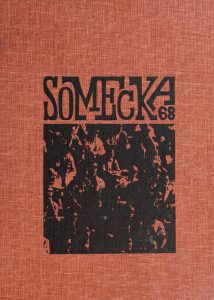
Front cover of the 1968 edition of Somecka, the yearbook for South Mecklenburg High School in Pineville, North Carolina.
You can see yearbooks and a number of other items we’ve scanned for Charlotte Mecklenburg Library on their contributor page. For more information about this partner, visit their website.


 The
The 


